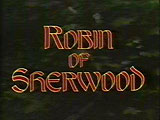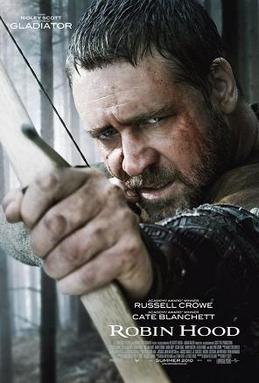
Robin Hood is a legendary heroic outlaw originally depicted in English folklore and subsequently featured in literature, theatre, and cinema. According to legend, he was a highly skilled archer and swordsman. In some versions of the legend, he is depicted as being of noble birth, and in modern retellings he is sometimes depicted as having fought in the Crusades before returning to England to find his lands taken by the Sheriff. In the oldest known versions, he is instead a member of the yeoman class. Traditionally depicted dressed in Lincoln green, he is said to have stolen from the rich to give to the poor.

Nottinghamshire is a ceremonial county in the East Midlands of England. The county borders South Yorkshire to the north-west, Lincolnshire to the east, Leicestershire to the south, and Derbyshire to the west. The largest settlement is the city of Nottingham (323,632).

Robin of Sherwood is a British television series, based on the legend of Robin Hood. Created by Richard Carpenter, it was produced by HTV in association with Goldcrest, and ran from 28 April 1984 to 28 June 1986 on the ITV network. In the United States it was shown on the premium cable TV channel Showtime and, later, on PBS. It was also syndicated in the early 1990s under the title Robin Hood. The show starred Michael Praed and Jason Connery as two different incarnations of the title character. Unlike previous adaptations of the Robin Hood legend, Robin of Sherwood combined a gritty, authentic production design with elements of real-life history, 20th-century fiction, and pagan myth. Robin of Sherwood has been described by historian Stephen Knight as "the most innovative and influential version of the myth in recent times". The series is also notable for its musical score by Clannad, which won a BAFTA award. A video game adaptation, Robin of Sherwood: The Touchstones of Rhiannon, was released in 1985.

Robin Hood: Prince of Thieves is a 1991 American action adventure film based on the English folk tale of Robin Hood that originated in the 12th century. Directed by Kevin Reynolds and written by Pen Densham and John Watson, the film stars Kevin Costner as Robin Hood, Morgan Freeman as Azeem, Christian Slater as Will Scarlett, Mary Elizabeth Mastrantonio as Marian, and Alan Rickman as the Sheriff of Nottingham.
Eustace the Monk, born Eustace Busket, was a mercenary and pirate, in the tradition of medieval outlaws. The birthplace of Eustace was not far from Boulogne. A 1243 document mentions a Guillaume le Moine, seigneur de Course, which indicates that the family lived in that vicinity.

Sir Guy of Gisbourne is a character from the Robin Hood legends of English folklore. He first appears in "Robin Hood and Guy of Gisborne", where he is an assassin who attempts to kill Robin Hood but is killed by him. In later depictions, he has become a romantic rival to Robin Hood for Maid Marian's love.
Will Scarlet is a prominent member of Robin Hood's Merry Men. He is present in the earliest ballads along with Little John and Much the Miller's Son.

Ranulf de Blondeville, 6th Earl of Chester and 1st Earl of Lincoln, known in some references as the 4th Earl of Chester, was one of the "old school" of Anglo-Norman barons whose loyalty to the Angevin dynasty was consistent but contingent on the receipt of lucrative favours. He has been described as "almost the last relic of the great feudal aristocracy of the Conquest".

Robin Hood and the Potter is a 15th century ballad of Robin Hood. While usually classed with other Robin Hood ballads, it does not appear to have originally been intended to be sung, but rather recited by a minstrel, and thus is closer to a poem. It is one of the very oldest pieces of the surviving Robin Hood legend, with perhaps only Robin Hood and the Monk older than it. It inspired a short play intended for use in May Day games, attested to around 1560. It was later published by Francis James Child as Child ballad #121 in his influential collection of popular ballads in the 1880s.

A Gest of Robyn Hode is one of the earliest surviving texts of the Robin Hood tales. Written in late Middle English poetic verse, it is an early example of an English language ballad, in which the verses are grouped in quatrains with an ABCB rhyme scheme, also known as ballad stanzas. Gest, which means tale or adventure, is a compilation of various Robin Hood tales, arranged as a sequence of adventures involving the yeoman outlaws Robin Hood and Little John, the poor knight Sir Richard at the Lee, the greedy abbot of St Mary's Abbey, the villainous Sheriff of Nottingham, and King Edward of England. The work survives in printed editions from the early 16th century, just some 30 years after the first printing press was brought to England. Its popularity is proven by the fact that portions of more than ten 16th- and 17th-century printed editions have been preserved. While the oldest surviving copies are from the early 16th century, many scholars believe that based on the style of writing, the work likely dates to the 15th century, perhaps even as early as 1400. The story itself is set somewhere from 1272 to 1483, during the reign of a King Edward; this contrasts with later works, which generally placed Robin Hood earlier in 1189–1216, during the reigns of Richard I of England and John, King of England.

Bows Against the Barons is a 1934 children's novel by British author Geoffrey Trease, based on the legend of Robin Hood. It tells the story of an adolescent boy who joins an outlaw band and takes part in a great rebellion against the feudal elite. Trease's first novel, Bows Against the Barons marks the start of his prolific career as a historical novelist. It is notable for reinterpreting the Robin Hood legend and revitalizing the conventions of children's historical fiction in 20th-century Britain.

Robin Hood is a 2010 action film based on the Robin Hood legend, directed by Ridley Scott and starring Russell Crowe, Cate Blanchett, William Hurt, Mark Strong, Mark Addy, Oscar Isaac, Danny Huston, Eileen Atkins, and Max von Sydow.
Gérard De Athée written in Magna Carta 1215 as Gerardi de Athyes. He was a Principal military commander and Lord from Athee Sur Cher in now France. He possessed his own Castle, Arms and badge of "A Lion contrapasssant qui retourne ca tete" of Guyenne Aquitaine and that as used by King Richard Coer De Leon under whom he is first referenced. He later seamlessly transferred to King John of England from 1211 to 1215 following the death of King Richard in 1199 at the siege of Chalus.
The Sheriff of Nottingham is the main antagonist in the legend of Robin Hood. He is generally depicted as an unjust tyrant who mistreats the local people of Nottinghamshire, subjecting them to unaffordable taxes. Robin Hood fights against him, stealing from the rich, and the Sheriff, in order to give to the poor; it is this characteristic for which Robin Hood is best known. The Sheriff is considered the archenemy of Robin Hood, as he is the most recurring enemy of the well-known outlaw.

William Brewer of Tor Brewer in Devon, was a prominent administrator and judge in England during the reigns of kings Richard I, his brother King John, and John's son Henry III. He was a major landholder and the founder of several religious institutions. In 1204, he acquired the feudal barony of Horsley in Derbyshire.
The Sheriff of Nottinghamshire, Derbyshire and the Royal Forests is a position established by the Normans in England.
Engelard de Cigogné was a 13th-century French-born administrator from Touraine who served King John of England.

Robert de Vieuxpont, also called Vipont, Veteripont, or de Vetere Ponte, Baron of Westmorland, was an Anglo-Norman noble landowner and administrator.
Philip of Oldcoates was an English nobleman and royal official.











